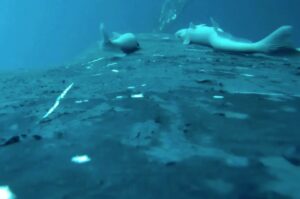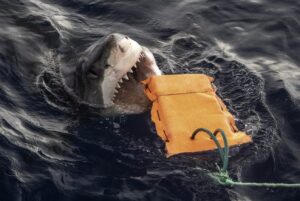It’s tempting to poke gentle fun at a group of scientists breaking forth in “audible gasps, hoots, and high fives” after discovering a new batch of hydrothermal vents along the Mid-Atlantic Ridge. But when you’ve devoted your life to a specialized subject, you’re allowed to get excited about it.
The scientists in question are part of an expedition whimsically dubbed In Search of Hydrothermal Lost Cities. The “cities” are towers of mud and sediment often formed by hydrothermal vents. It’s also worth noting this team named its ship the Research Vessel Falkor (too) and its remotely-operated vehicle (ROV) the SuBastian. Both names reference the classic and much-beloved-by-Millennials fantasy film The NeverEnding Story (just in case you happen to be reading this and you are over 45 or so).

Scientists prepping the SubBastion ROV. Photo: Schmidt Ocean Institute
This is a group of scientists who sound like they’d be fun to join for an ’80s-themed movie night.
After bad weather prevented the Lost Cities expedition from exploring its primary objective (the Kane Fracture Zone), this neverendingly optimistic team turned its sights to the Puy des Folles Volcano. While previous teams had noticed evidence of venting in the area, they hadn’t discovered any active vents.
Black smokers
SuBastian to the rescue. With its sophisticated suite of instruments and cameras, the intrepid ROV quickly detected “black smoker” hydrothermal vents, so named because the minerals they blast into the ocean have a high iron sulfide content.

An example of a ‘black smoker’ in the Marianas trench. Photo: NOAA Office of Ocean Exploration and Research
Such vents often belch forth mineral-rich water up to 371˚C. Studying them is important for understanding how life on Earth evolved, according to a National Oceanic and Atmospheric Administration (NOAA) press release. Indeed, hydrothermal vents often host a rich array of life specially evolved to withstand such extreme conditions. In fact, they thrive off the complex chemical reactions in the scalding water.
The black smokers discovered by the Lost Cities team were covered in shrimp that somehow managed to avoid boiling themselves right onto a cocktail platter despite their cataclysmically hot environment.
The scientists also took samples of microbes called extremophiles. Extremophiles live in a variety of bonkers conditions that seem to defy logic. Studying them “provides clues to help scientists learn more about the origins of life on Earth — and potentially other planets,” the NOAA press release enthusiastically concludes.
The expedition is ongoing, so who knows what the scientists aboard the Falkor will find next. Could it be racing snails? Please tell me it could be racing snails.






